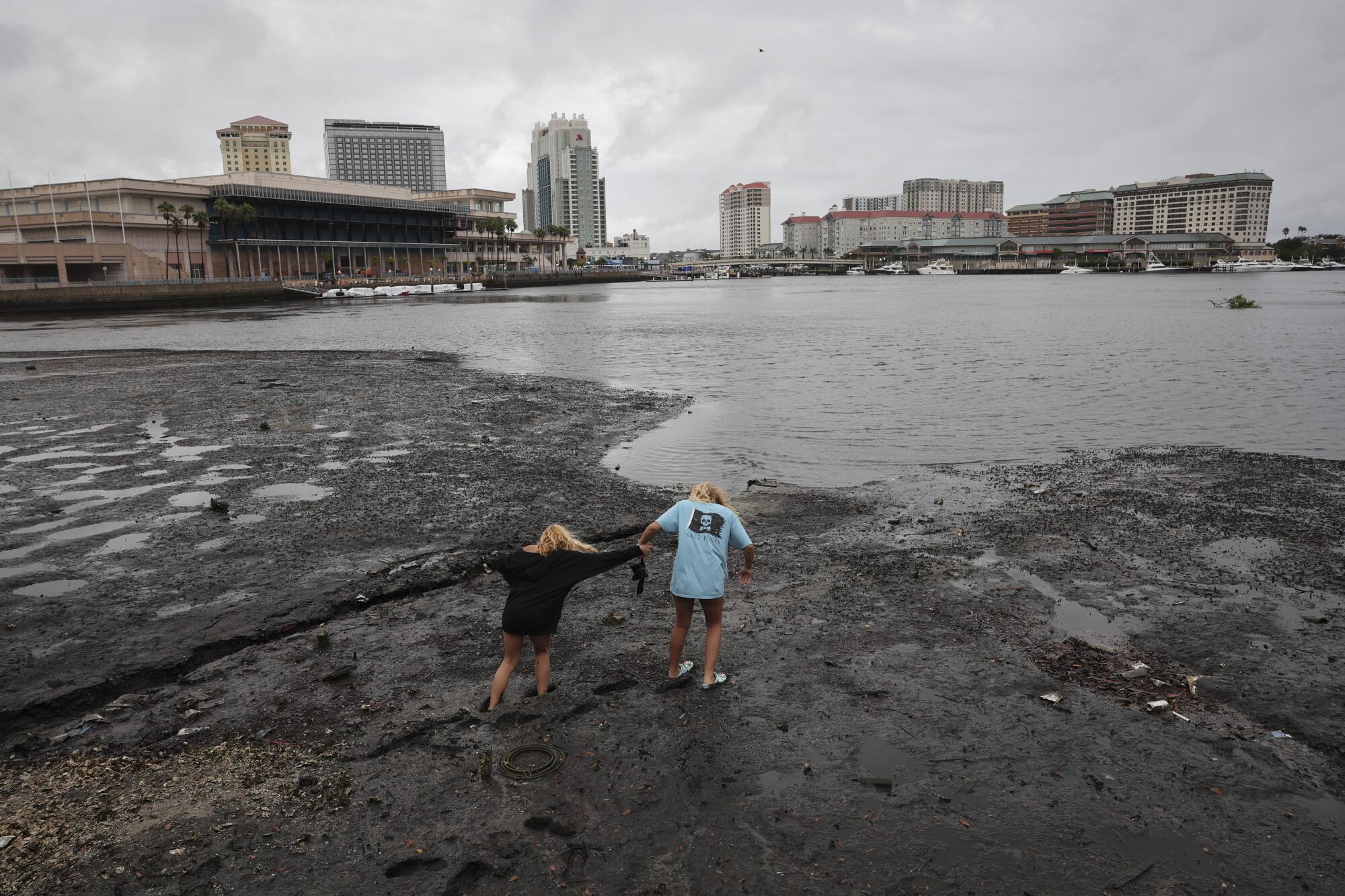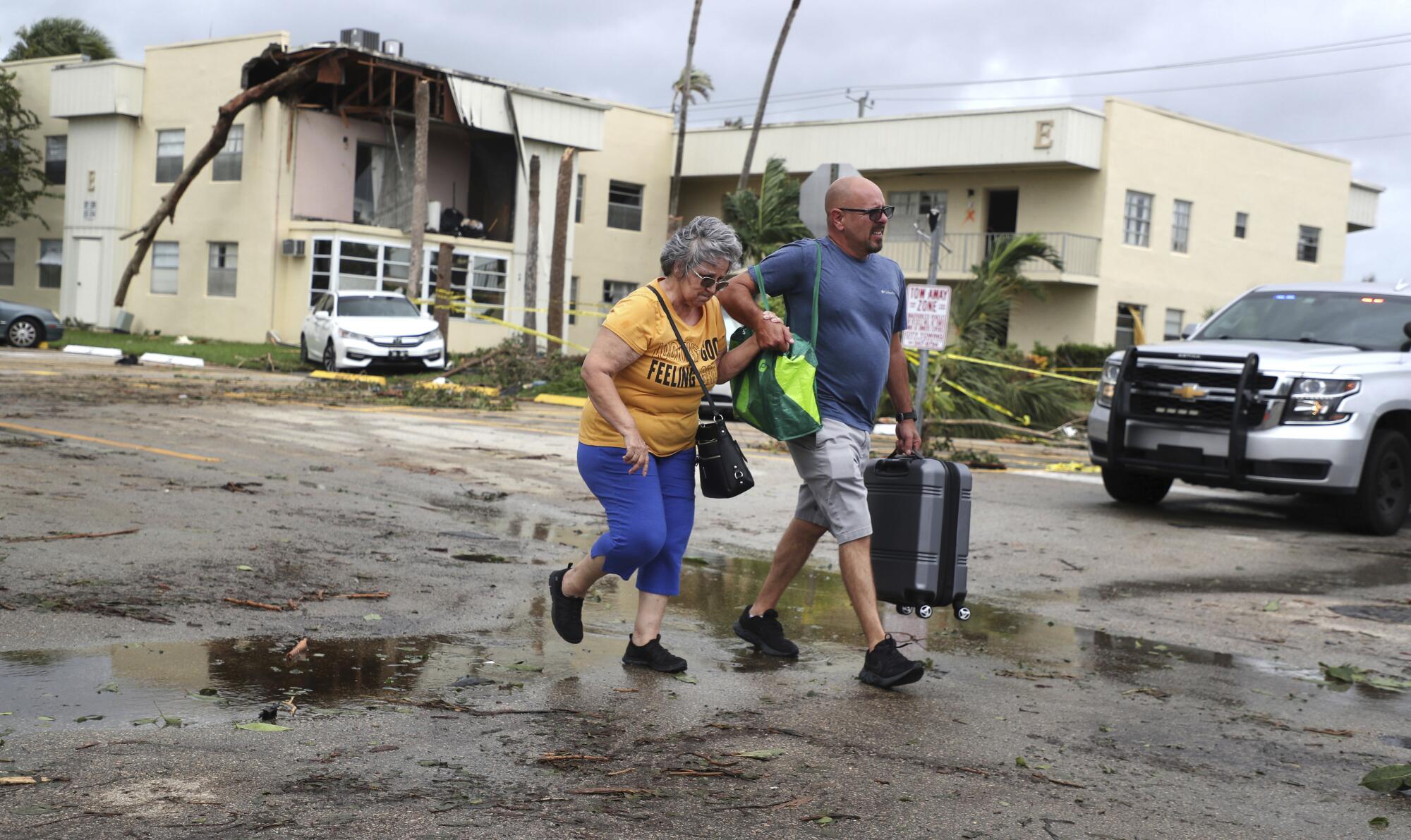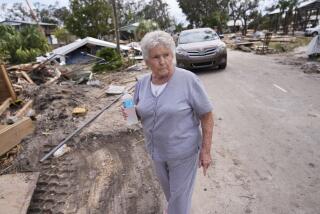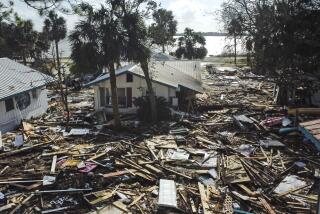
- Share via
ST. PETERSBURG, Fla. — Hurricane Ian, one of the most powerful storms ever recorded in the U.S., swamped southwest Florida on Wednesday, turning streets into rivers, knocking out power to 1.8 million people and threatening catastrophic damage farther inland.
A coastal sheriff’s office reported that it received many calls from people trapped in flooded homes. Desperate people posted to Facebook and other social sites, pleading for rescue for themselves or loved ones. Some video showed debris-covered water sloshing toward homes’ eaves.
The storm surge flooded a lower-level emergency room at a hospital in Port Charlotte, while fierce winds tore part of its fourth-floor roof from its intensive care unit, according to a doctor who works there.
Water gushed down from above onto the ICU, forcing staff to evacuate the hospital’s sickest patients — some of whom were on ventilators — to other floors, said Dr. Birgit Bodine of HCA Florida Fawcett Hospital. Staff members used towels and plastic bins to try to mop up the sodden mess.
The medium-sized hospital spans four floors, but patients were placed into just two because of the damage. Bodine planned to spend the night at the hospital in case people injured from the storm arrive there needing help.
“The ambulances may be coming soon, and we don’t know where to put them in the hospital at this point because we’re doubled and tripled up,” she said. “As long as our patients do OK and nobody ends up dying or having a bad outcome, that’s what matters.”
The hurricane’s center made landfall near Cayo Costa, a barrier island just west of heavily populated Fort Myers. As it approached, water drained from Tampa Bay.
Hurricane Ian made landfall in southwest Florida on Wednesday as a catastrophic Category 4 storm.
Mark Pritchett stepped outside his home in Venice around the time the hurricane came ashore about 35 miles to the south. He called it “terrifying.”
“I literally couldn’t stand against the wind,” Pritchett wrote in a text message. “Rain shooting like needles. My street is a river. Limbs and trees down. And the worst is yet to come.”
A boat carrying Cuban migrants sank Wednesday in the stormy weather in waters east of Key West. The U.S. Coast Guard initiated a search-and-rescue mission for 23 people and found three survivors about two miles south of the island chain, officials said.
Four other Cubans swam to Stock Island, just east of Key West, the U.S. Border Patrol said. Air crews continued to search for possibly 20 remaining migrants.
The Category 4 storm slammed the coast with 150-mph winds — just below Category 5 strength — and pushed a wall of storm surge that had accumulated during its slow march over the Gulf of Mexico. Nearly every home and business in three counties was without power.
The storm previously tore into Cuba, killing two people and bringing down the country’s electrical grid.
About 2.5 million people were ordered to evacuate southwest Florida before Ian hit, but by law no one could be forced to flee.
News anchors at Fort Myers television station WINK had to abandon their usual desk and continue storm coverage from another location in the newsroom because water was pushing into the building near the Caloosahatchee River.
Though Ian was expected to weaken to a tropical storm as it marched inland at about 9 mph, its hurricane force winds would probably be felt well into central Florida. Hours after Ian’s landfall, top sustained winds had dropped to 105 mph, making it a Category 2 hurricane. Still, storm surges as high as 6 feet were expected on the opposite side of the state, in northeast Florida.
As a ferocious hurricane bears down on South Florida, water managers desperately lower canals in anticipation of 4 feet of rain.
For the record:
10:54 p.m. Sept. 28, 2022An earlier version of this story mistakenly reported Charlotte County Sheriff Bill Prummell’s first name as Bull.
Sheriff Bill Prummell of Charlotte County, just north of Fort Myers, announced a curfew between 9 p.m. and 6 a.m. “for lifesaving purposes,” saying violators may face second-degree misdemeanor charges.
“I am enacting this curfew as a means of protecting the people and property of Charlotte County,” Prummell said.
Jackson Boone left his home near the coast and hunkered down at his law office in Venice with employees and their pets. Boone at one point opened a door to howling wind and rain flying sideways.

“We’re seeing tree damage, horizontal rain, very high wind — I think it’s a 100-plus sustained outside right now,” Boone said by telephone. “We have a 50-plus-year-old oak tree that has toppled over.”
In Naples, the first floor of a fire station was inundated with about 3 feet of water and firefighters worked to salvage gear from a firetruck stuck outside the garage in even deeper water, a video posted by the Naples Fire-Rescue Department showed. Naples is in Collier County, where the Sheriff’s Office reported on Facebook that it was getting “a significant number of calls of people trapped by water in their homes” and that it would prioritize reaching people “reporting life-threatening medical emergencies in deep water.”
Ian’s wind speed at landfall tied that of several other storms for the fifth-strongest hurricane to strike the U.S. Among them was Hurricane Charley, which hit almost the same spot on Florida’s coast in August 2004, killing 10 people and inflicting $14 billion in damage.
Toward a more sustainable California
Get Boiling Point, our newsletter exploring climate change, energy and the environment, and become part of the conversation — and the solution.
You may occasionally receive promotional content from the Los Angeles Times.
Ian made landfall more than 100 miles south of Tampa and St. Petersburg, sparing the densely populated Tampa Bay area from its first direct hit by a major hurricane since 1921.
Flash floods were possible across Florida. Hazards include the polluted leftovers of the state’s phosphate fertilizer mining industry and more than 1 billion tons of slightly radioactive waste contained in enormous ponds that could overflow in heavy rains.
The federal government sent 300 ambulances with medical teams and was ready to deliver 3.7 million meals and 925,000 gallons of water by truck once the storm passes.

“We’ll be there to help you clean up and rebuild, to help Florida get moving again,” President Biden said Wednesday. “And we’ll be there every step of the way. That’s my absolute commitment to the people of the state of Florida.”
The governors of Georgia, South Carolina and North Carolina declared states of emergency. Forecasters predicted that Ian will turn toward those states as a tropical storm, probably dumping heavy rain and causing flooding into the weekend.
More to Read
Sign up for Essential California
The most important California stories and recommendations in your inbox every morning.
You may occasionally receive promotional content from the Los Angeles Times.














